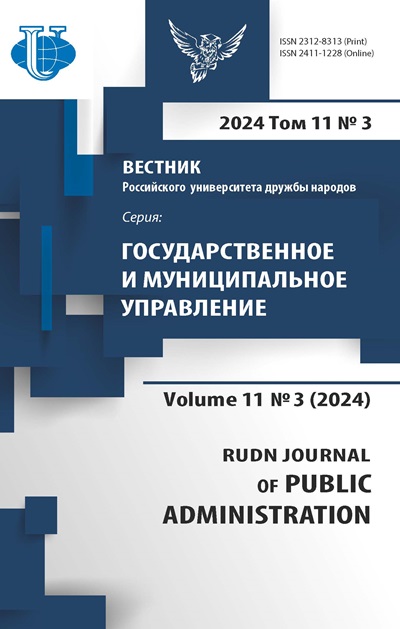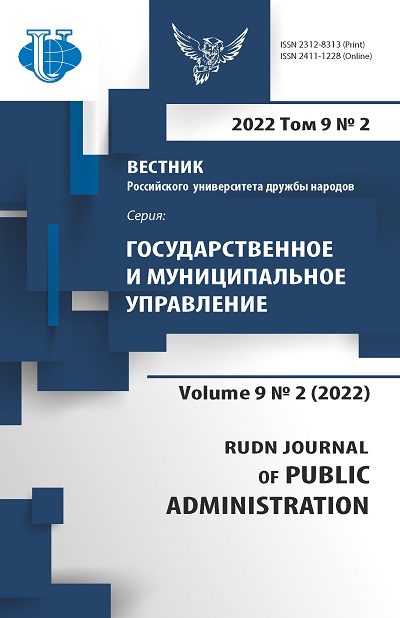Электронное управление в Нигерии: вызовы и перспективы
- Авторы: Огувбу Э.А.1, Гберевби Д.Э.1, Они С.О.1
-
Учреждения:
- Университет Ковенант
- Выпуск: Том 9, № 2 (2022)
- Страницы: 189-199
- Раздел: МЕЖДУНАРОДНЫЙ ОПЫТ ГОСУДАРСТВЕННОГО УПРАВЛЕНИЯ
- URL: https://journals.rudn.ru/public-administration/article/view/31480
- DOI: https://doi.org/10.22363/2312-8313-2022-9-2-189-199
Цитировать
Полный текст
Аннотация
Основная обязанность или функция правительств во всем мире состоит в том, чтобы соответствовать стремлениям, чаяниям и потребностям своих граждан. Бюрократические институты используются в администрировании как реальные инструменты для разработки и реализации государственной политики и программ, направленных на удовлетворение потребностей людей. Именно на этой препозиции в исследовании рассматриваются проблемы электронного управления в Нигерии. Из-за большой зависимости от вторичных источников данных в исследовании были использованы методы контент-анализа. Исследование выявило, что низкий уровень знаний об ИКТ, недостаточная правовая база и неадекватная инфраструктура относятся к числу проблем, препятствующих эффективному внедрению электронного управления в Нигерии. Исследование, с другой стороны, показало, что электронное управление имеет большой потенциал для страны, включая предоставление информации о вакансиях, систему электронной полиции, передачу информации и поддержку экономического развития. Исходя из выявленных проблем в исследовании была предложена рекомендация правительству страны обеспечить инфраструктуру ИКТ, в стране должно быть принято законодательство в области ИКТ, также правительство должно продемонстрировать приверженность политике электронного управления в стране. В заключении было отмечено, что электронное управление имеет решающее значение для создания в Нигерии подотчетного, отзывчивого и прозрачного правительства.
Ключевые слова
Об авторах
Эджироген А. Огувбу
Университет Ковенант
Email: augustine4best@yahoo.com
ORCID iD: 0000-0003-1422-3806
аспирант кафедры политологии и международных отношений
112104, Ота, НигерияДэниел Э. Гберевби
Университет Ковенант
Email: augustine4best@yahoo.com
ORCID iD: 0000-0002-3958-2699
PhD (государственное управление), профессор кафедры государственного управления
112104, Ота, НигерияСэмюэл О. Они
Университет Ковенант
Автор, ответственный за переписку.
Email: augustine4best@yahoo.com
ORCID iD: 0000-0003-3513-0844
PhD (политические науки), старший преподаватель
112104, Ота, НигерияСписок литературы
- Abah E.O., Nwokwu P.M. Problems and Prospects of E-Governance in an Emerging State: The Nigerian example. Journal of humanities and Social Science. 2019;24(1):14-21.
- Abasilim U.D., Edet L.I. E-Governance and its Implication Challenges in the Nigerian Public Service. Acta Universitatis Danubius. Administratio. 2015;7(1):30-42.
- Nchuchuwe F.F., Ojo A.D. Challenges and Prospects of Implementing E-Governance in Nigeria. Covenant University. Journal of Politics and International Affairs. 2015;2(3):1-19.
- Onuigbo R.A., Eme O.I. Electronic Governance and Administration in Nigeria: Prospects and Challenges. Arabian Journal of Business and Management Review (OMAN Chapter). 2015;3(3):18-26.
- Adeyemo A.B. E-Government Implementation in Nigeria: An Assessment of Nigeria’s e-Government ranking. Journal of Internet and Information System. 2011;2(1):11-19.
- Obasanjo O. Speech at Stakeholders’ Conference on National e-Government Strategies and Implementation for Nigeria. URL: http://www.nigeriafirst.org/objspeeches/2004/stakeholdersconf.html. Accessed: 30.10.2021.
- Ojo J.S. E-Governance: An Imperative for Sustainable Grassroots Development in Nigeria. Journal of Public Administration and Policy Research. 2014;6(2):77-89.
- Ayo C.K. Information and Communication Technology as a lever for Innovation in leadership. In T. Abioye., C. Awonuga and A. Amuwo. Leadership and Innovation in Africa’s Development Paradigm. Ota: Covenant University Press; 2014.
- Godse V., Garg A. From E-Government to E-Governance. URL: https://www.google.com.ng/gfe_rd=cr&ei=kreXVb2PEtLH8gft4YGwDw&gws_rd=ssl#q=godse+and+garg+2007 on 01-06-2021. Accessed: 30.10.2021.
- Providence R.I. Fourth Annual E-Government Study. URL: http://www.brown.edu/Administration/nevvs_Bureau/202106/01-021.html. Accessed: 30.10.2021.
- Ogidan J., Adekola O., Emmanuel G., Okogun O. ICT for Good Governance and SocioEconomic Development in Nigeria. World Scientific News. 2017;72(2):522-534.
- Duruji M., Dibia O. Methodologies for Using ICTS to Promote Good Governance: A Study of the Vehicles Inspection Office (Vio), Abuja. E-governance conference; 2017.
- CBN. 2021. URL: https://www.cbn.gov.ng/. Accessed: 30.10.2021.
- Monin M., Sahadev R. Application of ICT in Good Governance. International Journal of Advanced Research in Computer Science and Software Engineering. 2016;6:276-279.
- Budhiraja R. Electronic Governance - A Key Issue in the 21st Century, Additional Director, Electronic Governance Division, Ministry of Information Technology, Government of India. URL: http://www.mit.gov.in/eg/article2.htm. Accessed: 30.10.2021.
- Curriculum Guide on E-Governance for African government institutions; African Training and Research Centre in Administration for Development. UNESCO. 2007. URL: http://portal.unesco.org/ci/en/files/25720/11980630809curriculum_guide.pdf/curriculum%2Bguide.pdf. Accessed: 30.10.2021.
- Dode R.O. Prospects of E-Government Implementation in Nigeria, 1st International Conference on Theory and Practice of Electronic Governance. December 10-13. Macao, China; 2007.
- Omeire E., Omerie C. New Wine in Old Wine Skin: An Exploration of Major Constraints to E-Government Implementation in Nigeria. European Scientific Journal May 2014 edition. 2014;10(14):481-487.
- Okwueze F.O. E-Governance as a Tool for Public Sector Development in Nigeria. Nsukka: Society for Research and Academic Excellence 2. 2010. URL: http://academicexcellencesociety. com/e_governance_as_a_tool_for_public_sector%C2%AD_development_in_nigeria.html. Accessed: 30.10.2021.
- Gberevbie D., Ayo C., Duruji M., Abasilim U. E-Governance: Strategy for Militating Noninclusion of Citizens in Policy Making in Nigeria. 15th European Conference on e-Government, University of Portsmouth, United Kingdom, 18-19 June; 2015.
- OECD e-Government Flagship Report “The e-Government Imperative. OECD Public Management Committee, Paris: OECD; 2003.
- Blau A. Access Isn’t Enough. American Libraries. 2002;3(6):50-52.
- Smith B. E-government in Local Councils. Hunter’s Hill Council; 2002.
- Feng L. Implementing e-Government Strategy is Scotland: Current Situation and Emerging Issues. Journal of Electronic Commerce in Organizations. 2003;1(2):44-65.
- Ayo C.K., Ekong U. E-voting Implementation in Nigeria: Prospects and Challenges. Proceedings of the 8th European Conference on e-government, July 10-11; 2008.
















